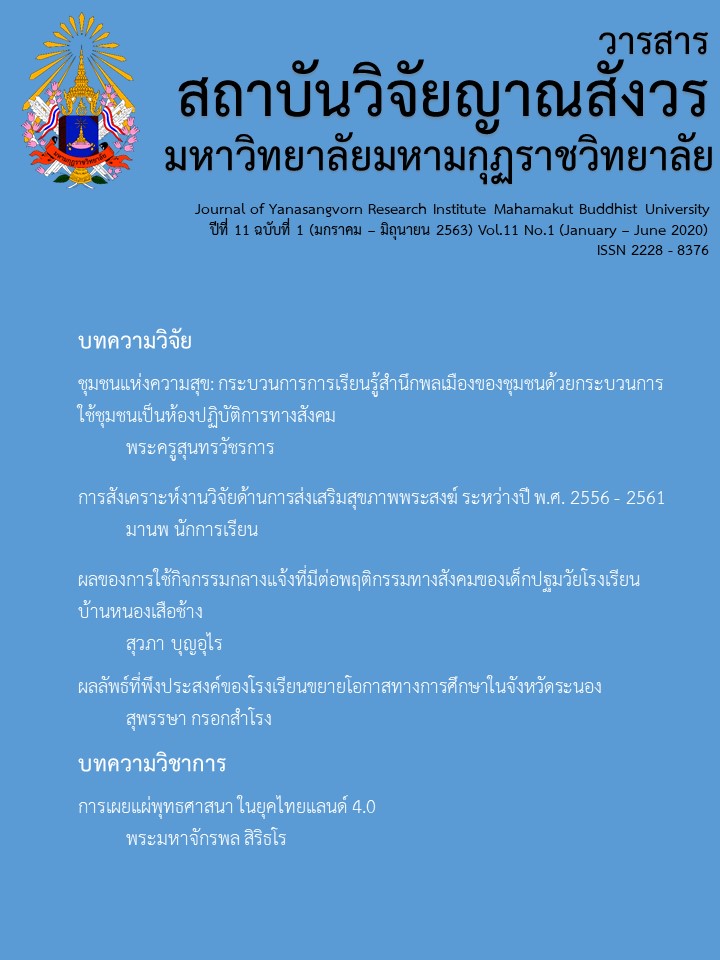BUDDHISM PROPAGATION IN THAILAND 4.0
Main Article Content
Abstract
Thailand 4.0 was the government’s vision in driving Thailand’s policies on development of new economy under the concept “For Stability, Prosperity and Sustainability.” The important mission of Thailand 4.0 was to create a way to drive the country’s development through technologies and innovations for sustainable development foundation in a long term. A significant development problem of Thai society was a process of improving human capabilities. After the Eighth National Economic and Social Development Plan (1997 – 2001), an integrated development was definitely focused by the country’s government on the people-centered development, so education became the country’s important base for developing the quality of people in the society. In addition, awareness of morality and ethics, and self-practice on the Buddha’s teachings looked like a tool or an instrument to enhance people’s quality; therefore, the Buddhist monks played their important roles to propagate the Buddhist principles and to recommend the Buddhists to integrate their living life with the Buddhist principles. The objective of the academic article “Buddhism Propagation in Thailand 4.0” was to present the model for teaching and propagation of the Buddha’s teachings through an up-to-date approach, which was referred to not only teaching or learning outside the classroom but also transforming the teacher’s role from a lecturer to a coach who gave his learners or students the advice on skills of learning and innovation, including information, media and technology. The teacher’s role change was aimed at boredom alleviation for learners or students studying the Buddha’s teachings and promotion of modern technology utilization as a tool for Buddhism propagation in the era of Thailand 4.0. For instance, video clips or short movies were made based on aspects and points of view, reflecting what the sender/encoder required the receiver/decoder to realize easily. In addition, the Buddhist teachings were exposed with simple expressions, funny and easily understood
Article Details
References
พระครูสุนทรประสิทธิธรรม (ประสิทธิ์ ชุตินฺธโร). (2558). กิจวัตร 10 : กระบวนการฝึกตนในพระพุทธศาสนา.วารสารครุศาสตร์ปริทรรศน์ฯ, 2(2), 101-107.
พระมหาปรีชา สาเส็งและคณะ. (2560).ประสิทธิผลการเผยแผ่พระพุทธศาสนาของพระธรรมทูตอาสาใน 5 จังหวัดชายแดนภาคใต้.วารสารวิจัยและพัฒนา วไลยอลงกรณ์ ในพระบรมราชูปถัมภ์, 12(3), 23-34.
ธีระพล มะอาจเลิศ. (2556). การวิเคราะห์รูปแบบการนาเสนอและกลยุทธ์การสื่อสารในการเผยแผ่พุทธธรรมของพระมหาวุฒิชัย วชิรเมธี (ว.วชิรเมธี) : กรณีศึกษาผลงานนิพนธ์ชุดธรรมประยุกต์สาหรับคนรุ่นใหม่.วิทยานิพนธ์ ศิลปศาสตรมหาบัณฑิต (การสื่อสารประยุกต์) คณะภาษาและการสื่อสาร สถาบันบัณฑิตพัฒนบริหารศาสตร์.
อดุลย์ วังศรีคูณ. (2557). การศึกษาไทยในทศวรรษที่21: ผลผลิตและแนวทางการพัฒนา.วารสารมนุษยศาสตร์และสังคมศาสตร์ บัณฑิตวิทยาลัย มหาวิทยาลัยราชภัฏพิบูลสงคราม, 8(1), 1-17.
อภินันท์ สิริรัตนจิตต์ และ นธี เหมมันต์. (2560). สมรรถนะในการจัดการเรียนการสอนที่เน้นผู้เรียน เป็นสำคัญ ของคณาจารย์มหาวิทยาลัยหาดใหญ่.การประชุมหาดใหญ่วิชาการระดับชาติและนานาชาติ ครั้งที่ 8 มหาวิทยาลัยหาดใหญ่.


